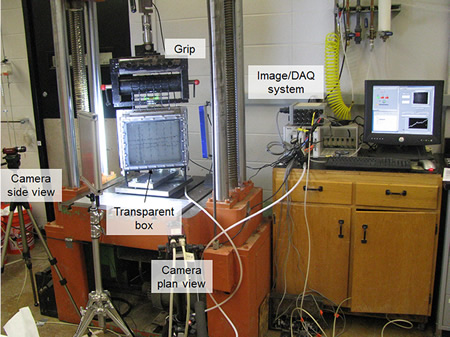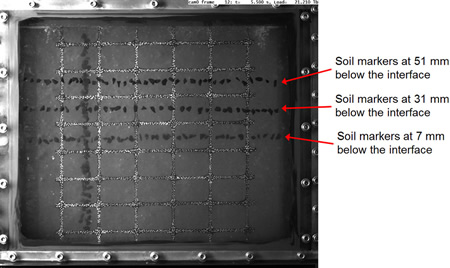
 The September 2015 issue of ASTM’s Geotechnical Testing Journal will feature a new article from Dr. Julio Ferreira and Dr. Jorge Zornberg. The focus of their work is “A Transparent Pullout Testing Device for 3D Evaluation of Soil–Geogrid Interaction.”
The September 2015 issue of ASTM’s Geotechnical Testing Journal will feature a new article from Dr. Julio Ferreira and Dr. Jorge Zornberg. The focus of their work is “A Transparent Pullout Testing Device for 3D Evaluation of Soil–Geogrid Interaction.”
Derived from a new, small-scale transparent pullout testing device—one with transparent bottom plate and sidewalls that fit in load frames used for geosynthetic tensile strength tests—the team began evaluating small displacements and strains, focusing on reinforcement applications in unbound base course of pavements. Transparent soil served in place of sand.
Following the testing trials, the soil-geogrid interaction was able to be 3D visualized (plan view of the soil-geogrid interface through the bottom plate of the pullout box and side view of the interface through the side walls of the box).
In the abstract, just published by the journal, the authors note:
Markers embedded in the transparent soil mass allowed tracking of soil particle displacements during the test. The tests were conducted using a polypropylene biaxial geogrid and both transparent soil and a conventional sand. Displacements along the geogrid were obtained continuously using digital image correlation (DIC) techniques in tests with transparent soil, and using tell-tails at five junctions in tests with sand. Comparison of test results with both soils showed that the transparent soil constitutes a good surrogate for sands in pullout studies. The pullout test with transparent soil also indicated that displacements along the geogrid could be properly described using an exponential function. Moreover, exponential fitting to the displacement data led to an exponential distribution of strains along the geogrid during pullout testing. Deflections of transverse ribs were first observed at early stages of the test when only 25 % of the maximum pullout force developed. The observed displacement patterns of the soil markers were useful in defining the zone of influence of the geogrid, which could be successfully quantified using the newly developed testing device.
The authors found the new equipment to be an effective tool for understanding soil-geogrid interaction. They found it particularly relevant to quantify interface stiffness, which could benefit pavement reinforcement applications the most.
IMPORTANCE OF THE RESEARCH
Unbound aggregate pavement reinforcement is a challenge for design engineers. Approaches to the use of reinforcement in base course for flexible paved roads remain, as the authors note, “highly empirical.” A major reason for this is that it is extremely difficult to quantify “the mechanisms that govern the soil–reinforcement interaction under small displacements.”
The researchers sought to assess local strains that develop in a geogrid to provide a more comprehensive view of soil-geogrid interaction mechanisms—ones that could be visualized through 3D analysis (digital image correlation [DIC]).
The 23-page article, currently listed as a first-look paper on the Geotechnical Testing Journal page, is available for purchase and download on ASTM’s website.











